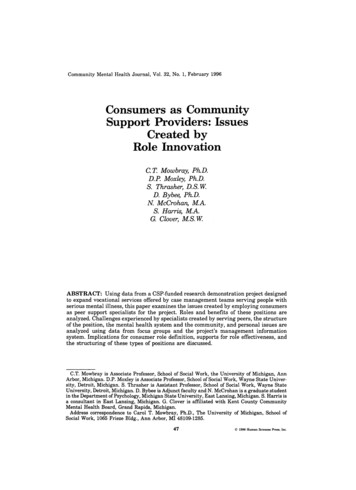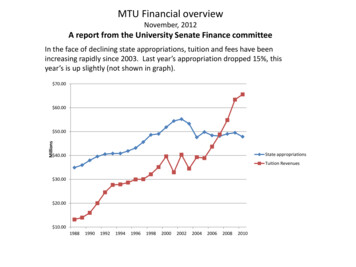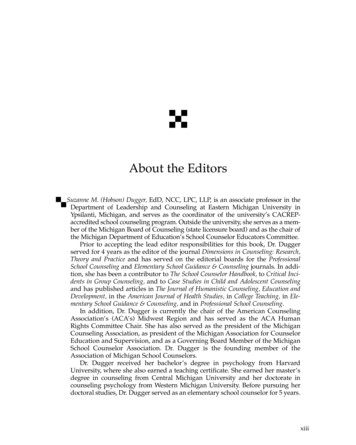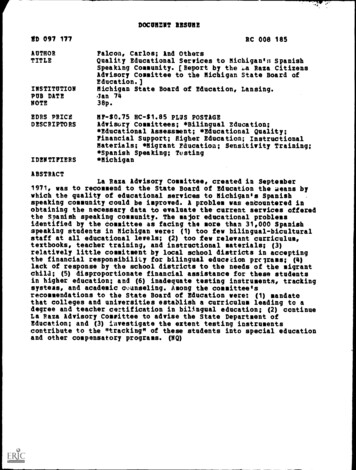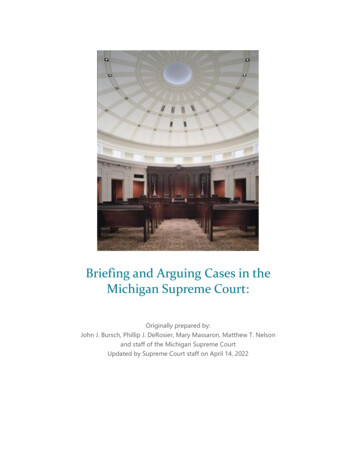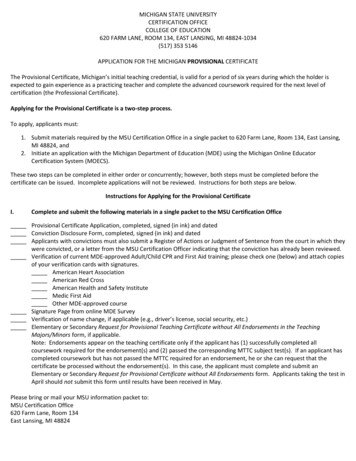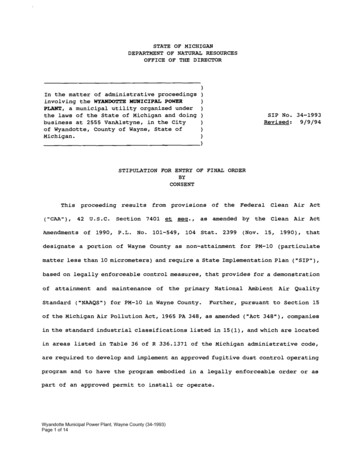
Transcription
STATE OF MICHIGANDEPARTMENT OF NATURAL RESOURCESOFFICE OF THE DIRECTOR)In the matter of administrative proceedings)involving the WYAHDOTTE MUHICIPAL POWER)PLANT, a municipal utility organized under )the laws of the State of Michigan and doing)business at 2555 VanAlstyne, in the City)of Wyandotte, County of Wayne, State of)Michigan.)SIP No. 34-1993Revised:9/9/94)STIPULATION FOR ENTRY OF FINAL ORDERBYCONSENTThis("CAA"),proceeding42resultsfrom provisionsof theFederalClean Air Actu.s.c. Section 7401 et seq., as amended by the Clean Air ActAmendments of 1990,P.L.No.101-549,104 Stat.2399(Nov.15,designate a portion of Wayne County as non-attainment for PM-101990),that(particulatematter less than 10 micrometers) and require a State Implementation Plan ("SIP"),based on legally enforceable control measures, that provides for a demonstrationofattainmentand maintenance ofthe primary National AmbientStandard ("NAAQS") for PM-10 in Wayne County.Air QualityFurther, pursuant to Section 15of the Michigan Air Pollution Act, 1965 PA 348, as amended ("Act 348"), companiesin the standard industrial classifications listed in 15 ( 1) , and which are locatedin areas listed in Table 36 of R 336.1371 of the Michigan administrative code,are required to develop and implement an approved fugitive dust control operatingprogram and to have the program embodied in a legally enforceable order or aspart of an approved permit to install or operate.Wyandotte Municipal Power Plant, Wayne County (34-1993)Page 1 of 14
SIP No. 34-1993 (Revised 9/9/94)Page 2The City of Wyandotte owns and operates the Wyandotte Municipal ElectricPlant("Plant"),whichis a municipal utility("Utility"),located at 2555VanAlstyne, City of Wyandotte, County of Wayne, State of Michigan.The MichiganDepartment of Natural Resources ("MDNR") alleges that the Plant is a significantsource of fugitive dust emissions which contribute to the non-attainment problem.Further,the requirementsforthecontrol offugitivedust,setforthinSection 15 of Act 348, apply to the Plant.The Utility and the MDNR stipulate as follows:1.The Air Pollution Act, 1965 PA 348, as amended, ("Act 348"), MCL 336.11et seq; MSA 14.58(1) et seq is an act to control air pollution in this state.2.The Directorofthe MDNR("Director")isauthorized pursuanttoSection 5 of Act 348 to administer and enforce all provisions of Act 348.3.The Director has delegated authority to the Air Quality Division ( "AQDChief") to enter into the Consent datepursuanttosection 16c of Act 348 is proper and execution("effective date of this Consent Order") by the AQD Chief.6.The emissions of fugitive dust from the Plant are subject to theopacity limitations and prohibitions contained in sections 15 and 15a of Act 348.The particulate matter and fugitive dust emissions from the Plant must not causeor contribute to a violation of the PM-10 NAAQS.Further, the CAA and Act 348require the application of all reasonably available control measures ( "RACM") forthe control of PM-10 emissions.Wyandotte Municipal Power Plant, Wayne County (34-1993)Page 2 of 14
Page 3SIP No. 34-1993 (Revised 9/9/94)7.This Consent Order is designed to ensure attainment and maintenance ofthe PM-10 NAAQS, compliance with Sections 15 and 15a of Act 348, and compliancewith the RACM requirements of the CAA and Act 348.COMPLIANCE PROGRAMa.On and after the effective date of this Consent Order, the Utilityshall fully comply with the provisions and requirements of the fugitive dustcontrol operating program and Recordkeeping for Fugitive Dust Sources Addendum,which is attached as Exhibit A,incorporated by reference,and made an en-forceable part of this Consent Order.RECORDKEEPING AND REPORTING9.On and after the effective date of this Consent Order, the Utilityshall keep records as specified in Exhibit A.10.On and after the effective date of this Consent Order, the recordsrequired pursuant to this Consent Order shall be kept on file at the Utility fora period of at least two (2) years, and shall be made available to MDNR uponwritten or verbal request.11.Beginning with the calendar quarter starting after the effective dateof this Consent Order, and quarterly thereafter, the Company shall submit to it,operationalrequirement, or recordkeeping requirement, as specified in Exhibit A, was notmet.This report shall, for each instance, explain the reason that the emissionlimit, operational requirement, or recordkeeping requirement was not met, theduration of the event, the remedial action taken, and a description of the stepswhich were taken to prevent a recurrence.Wyandotte Municipal Power Plant, Wayne County (34-1993)Page 3 of 14These reports shall be submitted
Page 4SIP No. 34-1993 (Revised 9/9/94)within 30 days following the end of the calendar quarter in which the data werecollected.The first such report shall be submitted no later than January 30,1994.GENERAL PROVISIONS12.Upon entry, this Consent Order, along with other supporting documen-tation required by the United States Environmental Protection Agency ( "U. s. EPA"),shall be submitted to the U.S.EPA for approval as a revision to the Michigan SIPin accordance with Part D, Section 171 et seq., of the Federal Clean Air Act, asamended by section 105 of the Clean Air Act Amendments of 1990.This consentOrder shall become effective immediately upon entry, except that this ConsentOrder shall have no effect on the federally-approved SIP unless and until thesubmitted SIP revision request is formally approved by the aychangeit'sprocesses, modify the fugitive dust control program contained in Exhibit A, ormodify the particulate emission control program contained in Exhibit B ("ControlPrograms"), in accordance with the following:A.Process Change( 1)The Company may change it's operations or processes which aresources of particulate and fugitive dust provided all of thefollowing conditions are met:( a)The provisions of the Control Programs continue to apply tothe subject operation or process;(b)The change does not result in an increase in the level offugitive dust or particulate emissions;Wyandotte Municipal Power Plant, Wayne County (34-1993)Page 4 of 14
SIP No. 34-1993 (Revised 9/9/94)(c)(2)Page 5The change is approved.The Company shall submit to MDNR a written description of theproposed change and how it meets the requirements of 13(A)(l).(3)The MDNR shall approve or disapprove the proposed change,inwriting, within 45 days from receiving a proposed change whichmeets the requirements of 13(A)(l).(4)Should the MDNR disapprove the proposed change, the disapprovalmust describe the specific reasons for the decision and must beforwarded to the Company.B.Control Program Revision(1)The Company may revise the Control Programs provided both of thefollowing conditions are met:(a)The Company demonstrates*, in writing, that the proposedrevision does not result in an increase in the level offugitive dust or particulate emissionsand submits thedemonstration to the MDNR for approval.(b)(2)The revision is approved.The MDNR shall approve or disapprove the proposed revision, inwriting, within 45 days from receiving a proposed revision usingan applicable U.S.EPA approved method to demonstrate the proposedrevision meets the requirements of 13(B)(l).(3)Should the MDNR disapprove the proposed revision, the disapprovalmust describe the specific reasons for the decision and must beforwarded to the Company.Wyandotte Municipal Power Plant, Wayne County (34-1993)Page 5 of 14
Page 6SIP No. 34-1993 (Revised 9/9/94)C.U.S.EPA NotificationUpon approval of a change pursuant to subsection A above, or a substitutionof acontrol measure pursuant to subsection B above, MDNR shall notifyU.S.EPA, in writing, of the revised provision which are enforceable forthe facility.D.Minor ModificationUpon adoption by the MDNR,and upon approval by u.s.EPA,of operatingpermit rules to implement the Permit Modification provisions recited at 40CFR 70. 7(e),the Company may modify afugitiveduetorparticulateemission source referred to in this Consent Order according to the termsand conditions contained in the operating permit rules.E.Minor Modification ApprovalUpon MDNR approval of a minor modification pursuant to subsection D above,the MDNR shall submit the approved minor modification to u.s.EPA as aproposed revision to the Michigan SIP.F.other Applicable RequirementsAny process change, control program revision, or minor modification madepursuant to this Paragraph does not affect the company's obligation toobtain a permit to install or operate required by Federal law or regulation, or contained in Part 2 of the Air Pollution Control ("APC") Rules andany other applicable requirement contained in the APC Rules or Act 348.Wyandotte Municipal Power Plant, Wayne County (34-1993)Page 6 of 14
SIP No. 34-1993 (Revised 9/9/94)*DemonstrationssuppressantmadePage 7pursuantapplicationsonto13(B) (1) stonlypetroleum resins, asphalt emulsions, or acrylic cements unless otherwiseexplicitly provided for by the applicable U.S.EPA approved SIP or U.S.EPAapproved method.14.This abatement program is not a variance subject to the 12 monthlimitation specified in Section 22 of the Air Pollution Act, being MCLA 336.32.15.The provisions of this Consent Order shall be binding on the partiesto this action, their officers, servants, employees, and attorneys, and on thosepersons in active concert or participation with them who receive actual noticeof this Consent Order.In the event the City of Wyandotte sells or transfers theWyandotte Municipal Power Plant, it shall advise any purchaser or transferee ofthe existence of this consent Order in connection with such sale or transfer.Within 30 calendar days, the City of Wyandotte shall also notify MDNR Staff, inwriting of such sale or transfer, the identity and address of any purchaser ortransferee, and confirm the fact that notice of this consent Order has been givento the purchaser or transferee.The purchaser must provide written agreement,to the Company, to assume the compliance responsibilities of the Consent Orderand provide a copy of the agreement to the MDNR Staff.16.Pursuant to the requirements of Section Sh of Act 348, the public wasnotified of a 30-day public comment period on this Consent Order which began onMarch 1, 1993 and a public hearing on this Consent Order which was held on March30, 1993.17.Section 16e of Act 348 may serve as a source of authority but not alimitation under which this Consent Order may be enforced.Wyandotte Municipal Power Plant, Wayne County (34-1993)Page 7 of 14Further, the Michigan
Page 8SIP No. 34-1993 (Revised 9/9/94)Environmental Protection Act ("MEPA"), 1970 PA 127, MCLA 691.1201 et seq; MSA14.528(201) et seq; and all other applicable laws may be used to enforce thisConsent Order.I,the undersigned,who is signing this Stipulation and Order for theUtility, certify that I am fully authorized by the Utility to enter into thisConsent Order and to execute and legally bind the Utility to it.Approved as to Form and content:WYANDOTTE MUNICIPAL POWER PLANTBy:Dated:S-,.,6:' :r.r .I'tlYThe above signatory subscribed and sworn to before me this.;;tqday, 1994.Notary PublicWILLIAM A. BOOKERNotary Public. Wayne County. MlMv Commission Expires July 12. 1995Wyandotte Municipal Power Plant, Wayne County (34-1993)Page 8 of 14
Page 9SIP No. 34-1993 (Revised 9/9/94)Approved as to Form:Approved as to Content:Dennis M. Drake, Acting ChiefAIR QUALITY DIVISIONDEPARTMENT OF NATURAL RESOURCESDated:/7Assistant Attorney General, In chargeNATURAL RESOURCES DIVISIONDEPARTMENT OF ATTORNEY GENERALDated:1oft!ify7FINAL ORDERThe Chief of the Air Quality Division having had opportunity to reviewthe Consent Order and having been delegated authority to enter into ConsentOrders by the Director of the Michigan Department of Natural Resources pursuantto the provisions of the Air Pollution Control Act;IT IS ORDERED that this Consent Order is approved and shall be entered inthe record of the MDNR as a Final Order.MICHIGAN DEPARTMENT OF NATURAL RESOURCESBy ---- ');/ Dennis M. Drake, Acting ChiefAir Quality DivisionDated:Wyandotte Municipal Power Plant, Wayne County (34-1993)Page 9 of 14
EXHIBIT AFUGITIVE DUST CONTROL PLANWYANDOTTE MUNICIPAL ELECTRIC PLANT1.Facility Name and Address:Wyandotte Municipal Power Plant2555 VanAlstyneWyandotte, Michigan 481922.Operator Name and Address:Mr. 'l!elft Ui ebb:aza,g:A' ,J.S.fI( 11 '1 7"".fCity of WyandotteDepartment o; Municipal Services3005 Biddle AvenueWyandotte, Michigan 481923.summary of Source Descriptions and Control MeasuresThe Wyandotte Municipal Electric Plant consists of three (3) coal-firedboilers, one (l) natural gas-fired boiler, three 0() steam-turbine generators,.iil.RQ- s iirea cerob:in@g:-qzr:l:a: m:t-i;:t.of4.Attached drawing No. 8605-SSP-001 shows location of storage piles, conveyorloading operations, traffic pattern and location of unloading and transportingoperations.5.Estimate of Fugitive Dust Emissions:An estimate of fugitive dust emissions has been calculated using AP-42"Compilation of Air Pollution Emission Factors." The calculations are attachedand denoted as Exhibit No. 1.Based on these calculations, fugitive dustemissions from the Wyandotte facility are estimated to be approximately 5. 37 tonsper year.It should be noted that some of the Wyandotte site specific parameters falloutside the range of applicability of the equations. Still, the equations of AP42 are the best source available for making estimates of fugitive dust emissions.6.Management Practices:Storage Pile:The Wyandotte facility has two (2) coal storage piles.One pile is forstoker coal while the other contains run-of-mine coal for use in the pulverizedcoal-fired boiler.These piles encompass a total area of approximately 2. 4acres.Control of fugitive dust from the storage piles will be maintained througha combination of compaction and water spraying. Compaction is accomplished usinga bulldozer and is performed when coal is originally unloaded. The run-of-minecoal pile is generally the active pile and it is, therefore, compacted on a dailybasis. Water spraying of the piles will be performed during the warmer weatherWyandotte Municipal Power Plant, Wayne County (34-1993)Page 10 of 14
-2months, April through the first two weeks of November. The application rate willbe approximately 0.25 inches of water per square foot of surface area. Frequencyof application will depend on weather conditions. However, it is proposed thatthe pile be sprayed on the fourth consecutive day of no precipitation. During dryand windy conditions, extra precautions and/or water spraying will be performedin order to minimize any fugitive emissions during compacting operations.Coal Handling:coal handling consists of the following processes:1.2.3.4.Unloading coal from the self unloading barge to the coal pile.Compacting the coal.Moving the coal to the truck hopper.Conveying the coal from the truck hopper to the coal bunkers.Coal is transported to the Wyandotte facility by barge. The barges are ofthe self loading type, using a conveyor system to unload the coal. Duringunloading, fugitive emissions will be minimized by water spraying and byminimizing the height between the coal pile and the conveyor. It is proposed thatthe distance between the conveyor and coal pile not exceed fifteen (15) feet.Water will be sprayed at a rate of approximately 12 gallons per ton of coal (100lbs water /ton coal) This will increase the coal's moisture content fromapproximately 5% to 10% and should significantly decrease fugitive emissions. Thespray system will utilize the same pumping station that is used for spraying thecoal pile.Compacting the coal occurs during and immediately after the coal isunloaded. This is a part of routine operation and therefore occurs at noadditional cost.During dry and windy conditions, extra precautions and/or water sprayingwill be performed in order to minimize any fugitive emissions during bothcompaction and unloading operations.Moving of the coal to the truck hopper differs for the two (2) types ofcoal. The stoker coal must be carried from the pile using a front end loader anddropped into the truck hopper. Minimizing fugitive dust from this operation willbe accomplished by minimizing the drop height from the front end loader to thetruck hopper. It is proposed that this distance not exceed two (2) feet. Thestoker coal is used for boiler No. 5 which is operated on an intermittent basis.Therefore, front end loader operation will also be on an intermittent basis. Somespillage will occur due to front end loader operation. This spillage will bepicked up and placed back in the storage pile three (3) times per week. The runof-mine coal is pushed to the truck hopper using a bulldozer. Water spraying ofthe pile will assure that the coal has some surface moisture. This will minimizefugitive dust emissions during operations. This combined with the fact that norun-of-mine coal is dropped should result in acceptable levels of fugitive dust.Transporting of the coal from the truck hopper to the coal bunkers isaccomplished by belt conveyors. The conveyors are totally enclosed (360 degrees)in an aluminum sided coal gallery. Once per week, the transfer tower is cleanedresulting in a small discharge of coal from a floor grate. The coal which doesfall to the ground is put back on the pile as a part of normal operation.Wyandotte Municipal Power Plant, Wayne County (34-1993)Page 11 of 14
-3Roadways:As shown on the attached drawing, the Wyandotte facility has three (3) typesof road surfaces - paved, gravel and dirt.For reasons of safety, vehicle speeds on these roadways typically do notexceed 10 mph. This slow traffic pattern lends itself to minimizing fugitive dustemissions. However, additional levels of dust control are planned.It is proposed that fugitive dust from the paved road be minimized by havingthe roadway cleaned once per week during the period from April l to mid-November.Road cleaning will be performed by the Wyandotte Department of Public Works usingan Elgin vacuum street sweeper. This vacuum sweeper is of the three (3) wheelwater spray and broom variety typically used by municipalities. Cleaning thepaved roads should result in no additional cost to the City since the servicewill be provided by another City department.Control of fugitive dust from unpaved areas will be performed through theuse of a 38% calcium chloride solution. Material safety data sheets for thisproduct are attached and denoted as Exhibit No. 2. For the dirt area, it isproposed to make five (5) applications of calcium chloride during the April tomid-November period. Applications would occur in early April, early June, lateJuly, late August and late September. The liquid would be applied by anapplication resulting in a coverage of 1 gallon per 20 square feet. The entiredirt area would be covered in each application. This equates to an area ofroughly 57,500 square feet. Therefore, each application would require 2,875gallons. It is proposed that the entire gravel area be sprayed once per year inearly June. The center strip of the gravel will be sprayed an additional four (4)times per year at the same time that the unpaved roads are sprayed. The centerstrip is the area that is used for traffic flow. The side areas are for parking.The center strip area to be sprayed is approximately 3600 square feet. Calciumchloride would be applied at the same rate as the dirt area, one (1) gallon per20 square feet. Therefore, application to the center strip area will require 180gallons per application. The entire gravel area is approximately 20,000 squarefeet in size. The once a year application to this entire area will require 1,000gallons.Calcium Chloride Alternative:An asphalt emulsion applied at the manufacturer's recommended dilution ratioand application rate is an acceptable alternative to calcium chloride applications required for unpaved areas. The frequency for asphalt emulsion applicationis the same as that required for calcium chloride, given under the heading of"Roadways."Fly Ash Silo Unloading:Fly ash from boiler operation is collected using an electrostatic precipitator, baghouse and mechanical collector. The fly ash is pneumaticallytransported to the storage silo. Fly ash from the silo is unloaded into trucksusing a rotary dustless unloader model No. 530 manufactured by United ConveyorCorp. The unloader is equipped with water spray nozzles and a blade assembly andoperates such that the water used is limited to that required for dustprevention. The unloader is designed to pass 1440 cubic feet of dry ash per hourWyandotte Municipal Power Plant, Wayne County (34-1993)Page 12 of 14
-4with a water application rate of 60 GPM. Assuming a fly ash density ofapproximately 60 Lbs/cubic feet. This equates to 500 lbs of water per 1440 lbsof dry fly ash resulting in a wet fly ash having a moisture content of approximately 25. 7%. A minimal amount of additional water is sprayed into the ash truckbed upon completion of unloading.Operation of the unloader is a routine part of operation. For the purposesof fugitive dust control, it is performed at no additional cost to the City.Coal Analysis:A summary of coal analyses performed as part of a recent stack test areincluded in Exhibit No. 3. The coal samples were taken downstream of the boilerNo. 7 pulverizers.(Note: See attached DNR required Recordkeeping for Fugitive Dust SourcesAddendum for additional information.)Wyandotte Municipal Power Plant, Wayne County (34-1993)Page 13 of 14
ADDENDUMRECORDKEEPING FOR FUGITIVE DUST SOURCESREQUIRED RECORDSUNPAVED ROADS/LOTS1.2.3.4.s.6.7.PAVED ROADS/LOTS1.2.3.4.STORAGE PILES/MATERIALHANDLING1.2.3.4.5.6.7.DATE OF TREATMENTCONTROL MEASURE USEDRESPONSIBLE PERSON'S INITIALSNAME OF PRODUCT APPLIEDAMOUNT OF SOLUTION/WATER APPLIEDDILUTION RATIOROAD SEGMENT/LOT IDENTIFICATIONDATE OF TREATMENTCONTROL MEASURE USEDRESPONSIBLE PERSON'S INITIALSROAD SEGMENT/LOT IDENTIFICATIONDATE OF TREATMENTCONTROL MEASURE USEDRESPONSIBLE PERSON'S INITIALSDILUTION RATIO (IF APPLICABLE)AMOUNT OF DUST SUPPRESSANT/WATERAPPLIEDIDENTIFICATION OF PILE/MATERIALHANDLING OPERATION TREATEDEQUIPMENT USEDOPTIONAL RECORDSWEATHER CONDITIONS1.2.3.Wyandotte Municipal Power Plant, Wayne County (34-1993)Page 14 of 14PRECIPITATIONTEMPERATUREWIND DIRECTION AND VELOCITY
The City of Wyandotte owns and operates the Wyandotte Municipal Electric Plant ("Plant"), which is a municipal utility ("Utility"), located at 2555 . Department of Natural Resources ("MDNR") alleges that the Plant is a significant source of fugitive dust emissions which contribute to the non-attainment problem. Further, the requirements for .



